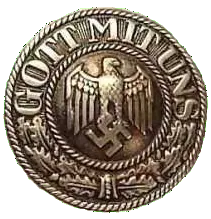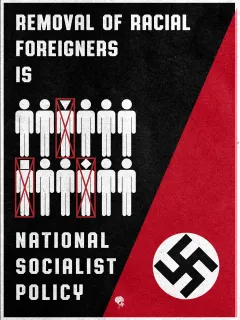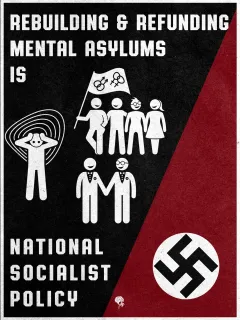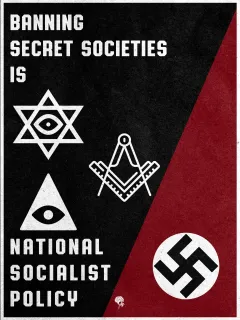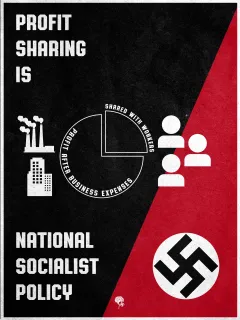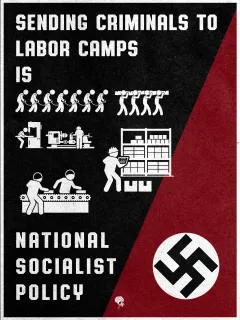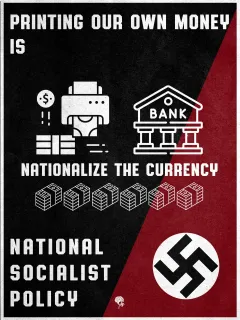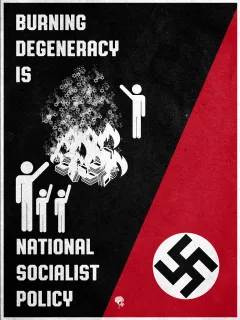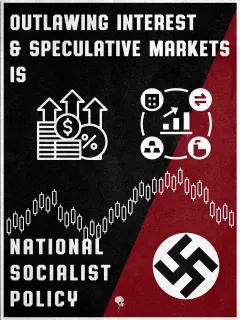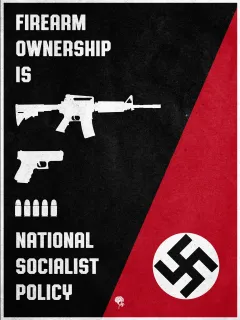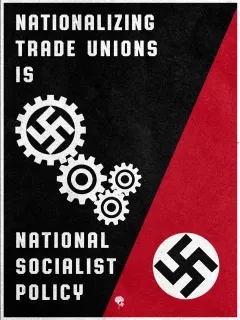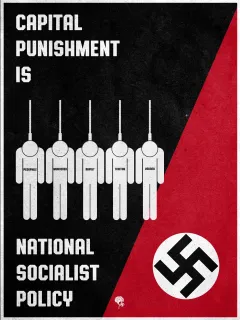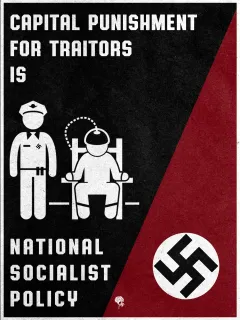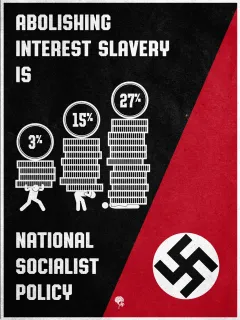Myths, Wartime Propaganda and the Burning of the Reichstag
From The Barnes Review, January, 1996. I wrote them and asked to reproduce this article, and never received a reply. So here it is, at least until they do answer me. - WRF
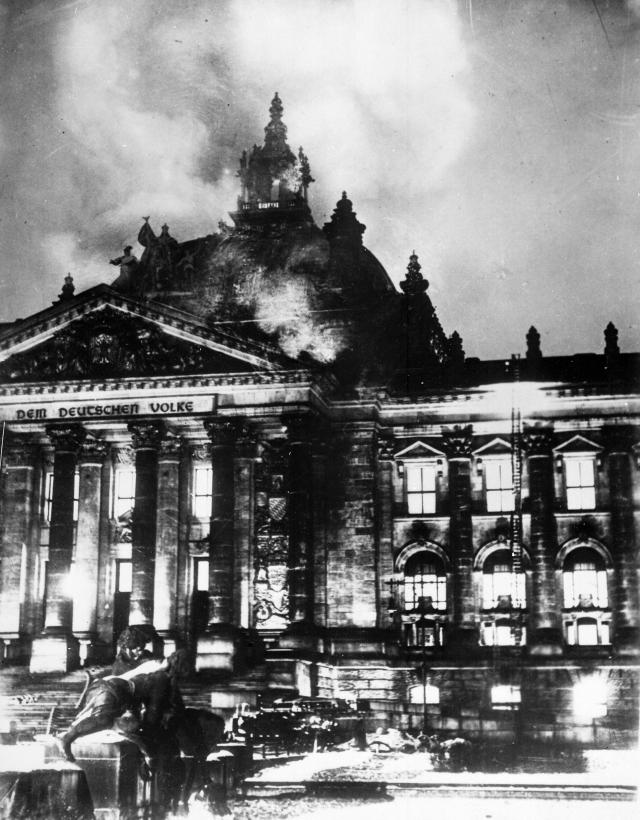 By FRED BLAHUT
By FRED BLAHUT
If the burning of the German Reichstag brought the National Socialists to power in 1933, were the Nazis responsible for the arson? If not, who was?
By 1933, Germany was ripe for another revolution. The Moscow-backed communist revolutions of 1919 had been put down at awful cost. And then the Allies imposed "reparations" that stripped the country of its ability to employ its workers and feed its people, including a British-engineered blockade that resulted in the deaths of hundreds of thousands of Germans by starvation.
The worldwide depression of 1929 hit the country, still staggering under the yoke of the Treaty of Versailles, in the gut. Food was scarce. Jobs were disappearing. Those who had jobs earned money that was close to worthless.
It was clear that the centrist government of President Paul von Hindenburg and Chancellor Heinrich Bruning, under extreme pressure from both the left and the right, could not hold. Fearing civil war, Hindenburg dismissed Bruning and in January of 1933 appointed Adolf Hitler, leader of the National Socialists, as chancellor, even though Hitler had no absolute majority in the lower chamber of the German Parliament-the Reichstag.
And then, on the night of February 27, the Reichstag building burned.
It is important to note that, following the armistice of 1918, British Prime Minister lloyd George had promised the British voters "to squeeze the German lemon until the pips squeaked." Germany had been stripped of its industry, its coal reserves in the Saar and the manufacturing capacities of Alsace-Lorraine.
The German Navy and merchant fleet had been seized; export barriers had been established for German products while free trade was imposed on imports produced by the Allies.
According to Leon Degrelle: "Germany was experiencing near-famine conditions. It was at this moment the Allies decided to confiscate a substantial part of what was left of Germany's livestock." (Hitler: Born at Versailles; Institute for Historical Review, 1987.)
Thomas Lamont, the American representative of the Allied powers "overseeing" Germany, was quoted: "The Germans were made to deliver cattle, horses, sheep, goats etc .... A strong protest came from Germany when dairy cows were taken to France and Belgium, thus depriving German children of milk."
According to Degrelle, "The question was now: Who was going to break the chains?
"Germany looked for an avenger to smash the Treaty of Vengeance. The avenger could not belong to the conventional right and left wings of German politics or any other Establishment entities, whether financial, military or religious."
In 1925, following the death of German President Friedrich Ebert, Hindenburg, a hero of World War I, was persuaded to run for president. He won easily. But, aging and ill, Hindenburg was not the national leader to bring Germany back from the abyss.
Prior to Hitler's appointment, the Reichstag had been suspended several times with rule by presidential decree. Neither the left nor the right believed it was Hindenburg himself who was running the country, which staggered on ineffectually. By 1933, Hindenburg had become senile.
On this point, European newsman Alec de Montmorency tells a story that was making the rounds in the Paris clubs frequented by journalists. Hindenburg, the story goes, asked one of his close aides in early 1933: "Who is that young man with a mustache who keeps bringing me papers to sign?"
Immediately after Hitler's appointment, the Reichstag was dissolved and new elections set for March 5. A violent election campaign ensued.
On February 24, the police raided Communist Party headquarters. It was announced that they had discovered plans for a new communist revolution. But they either didn't discover what they said that they had, or the evidence, for unknown reasons, was suppressed, because such documentation was never made public.
Then came the Reichstag fire. Hitler immediately blamed the communists. Hindenburg proclaimed a state of emergency and issued decrees suspending freedom of speech and assembly. Thanks to the "Red scare," the National Socialists and their allies, the German Nationalists, won a bare majority in the general election of March 5.
Shortly thereafter, first the Communist Party, and then all other parties except the National Socialist,were made illegal. The burning of the Reichstag was the spark that set the country ablaze. If, then, the fire was what catapulted Hitler to power, is it not reasonable to assume that the National Socialists had a hand in it? That was the consensus of propaganda in the United States, France and Great Britain.
The National Socialists blamed the communists, and tried to establish the guilt of Communist Party leaders in a trial at the High Court at Leipzig. They failed.
That led to the generally accepted theory that the National Socialists themselves torched the building. This version has been generally accepted. It appears in most textbooks and many reputable historians repeat it. According to A.J.P. Taylor in History Today, "I myself accepted it unquestioningly, without looking at the evidence."
But someone did look at the evidence: A retired civil servant-and anti-Nazi named Fritz Tobias. He began his project, it is reported, with the idea of settling once and for all the fact that the Nazis had been responsible for the fire. But that's not what he discovered. The results of his investigation were serialized in the German weekly Der Spiegel in 1950.
Here's the story as detailed by Tobias.
At just about 9 pm on February 27, a theology student -later a lecturer at Bremen-named Hans Floter was on his way home after a day of research and study at the library. As he crossed the open space in front of the Reichstag, he heard the sound of breaking glass. He looked up and saw someone climbing into the building through a window on the first floor. The building was otherwise deserted except for a night watchman who apparently did not hear the breaking glass.
Floter ran to the comer and found a policeman. "Someone is breaking into the Reichstag," he reported. The two men ran back to the building. Through the window they saw a shadowy, unidentifiable figure and something more ominous-flames. It was 9:03 pm. Floter, having done his duty, went home. He had not yet had supper and was hungry.
At this point, another passer-by joined the policeman, a young printer called Thaler, who was, incidentally, a Social Democrat, and definitely no supporter of the National Socialists. Thaler shouted: "Shoot, man, shoot." The policeman fired his revolver into the building and the shadowy figure disappeared.
The policeman ran to the nearest police post and gave the alarm. The time recorded was 9:15 pm. Within minutes police backup arrived at the Reichstag, At 9:22, a police officer tried to enter the Debating Chamber. He was driven back by the flames. At 9:27, the police discovered and arrested a half-naked young man. He was a Dutchman named Marinus van der Lubbe.
Meanwhile, the fire brigade had also been alerted. The first report is recorded at 9:13. The first engine reached the Reichstag at 9:18. But the firemen had problems entering the building to fight the blaze. Only one side door was kept unlocked after 8 pm. The firemen, not knowing this, went to the wrong door.
Gaining entrance, the firemen fought the first fires they came to-small blazes in the corridors, it turns out, and not the main fire. Eventually, the full strength of the Berlin fire brigade was mobilized, a force of some 60 engines. The time was 9:42. But by then, the building was beyond help.
Seen as evidence of Nazi involvement in the blaze was the fact that across the street from the Reichstag building was the residence-sometimes called a palace-of its president. The National Socialists being in charge of the legislative body, the president of the Reichstag on February 27, 1933 was Nazi leader Hermann Goering. But Goering had not yet moved in.
The building was unoccupied except for an apartment on the top floor which Goering had lent to "Putzi" Hanftstaengl, Hitler's foreign press chief. Hearing a commotion, Hanftstaengl looked out the window and saw the Reichstag burning. He knew that Hitler and Josef Goebbels were at a party nearby. He phoned Goebbels, who thought Hanftstaengel was playing some sort of practical joke and hung up. Hanftstaengel called back. Goebbels checked with the police and found the report was true.
Within a few minutes he, Hitler and a large group of National Socialists who had been at the party arrived at the Reichstag. An English journalist, Sefton Delmer, managed to join the crowd. Hitler, he reported, was very upset certainly not the demeanor of a man responsible for the action. "This is a communist plot, the signal for an uprising," Delmer reported Hitler yelling to his supporters. "Every communist official must be shot. The communist members [of the Reichstag] must be hanged."
Van der Lubbe, meanwhile, had been taken to the nearest police station. He was interrogated until 3 am of February 28. He was allowed to sleep for a few hours, awakened, given breakfast and, at 8 am, the questioning resumed. He gave clear, coherent answers. He described how he had entered the Reichstag and started a series of fires, even using some of his clothing to help the blazes get going.
The police, thoroughly and methodically, checked his story. They retraced his route through the Reichstag with a stopwatch and determined that the timing was correct for his entrance through a window to the time of his arrest. Van der Lubbe was clear about his motive. He had hoped that the entire German people would protest against the Nazi government. When this did not happen, he determined that he would protest individually.
Although the burning of the Reichstag was certainly a signal for revolt-he called it a "beacon" -he had given the signal alone, he insisted. He denied that he had any associates or fellow plotters. He said he knew no Nazis. He was not a member of the Communist Party. He was a socialist, more politically in tune with the left wing of the centrist government.
Van der Lubbe proved a willing witness against himself. He traced his movement for police during the weeks prior to the arson. He had drifted across Germany, apparently searching for anti-Nazi sentiment and finding nothing approaching the mass revolt he had hoped for. He even told police where he had purchased "fire-starter," a petroleum-based liquid used, as its name implies, to start fires, and matches. The police checked his story. Everything he said proved to be correct.
The police officials conducting the investigation concluded that van der Lubbe was deranged-but above average in intelligence, with an exceptionally accurate sense of place and direction. He knew where he had been and what he had been doing and remembered even small details of his wanderings, purchases and arson.
His interrogators were experienced men, professionals with no political connections. They became convinced that he was telling the truth and that he had set the fire at the Reichstag all by himself, with no outside help or even encouragement. Firemen who had been at the scene agreed that the sequence of arson events detailed by van der Lubbe matched their investigation results.
That conclusion didn't sit well with Hitler and the upper cadre of the National Socialists,locked in a bitter battle with the communists to gain control of the Reichstag. They had committed themselves to the proposition that the fire was a communist plot. Whether or not they believed this, it was the story that had to be sold to the German public if they were to defeat the communists at the polls.
Van der Lubbe and four others were tried for the arson; a man named Torgler, the leader of the communist bloc in the Reichstag, and three Bulgarian communists including Georgi Dimitrov.
Van der Lubbe's guilt was beyond question. He had been found in the Reichstag and he admitted starting the fires. But that wasn't what was worrying the Nazis. Everyone accepted van der Lubbe's guilt. It was the communists the Nazis wanted convicted.
A number of "expert" witnesses were produced-with Nazi help-by the prosecution with the intention of proving that the fire could not have been started by one man. But van der Lubbe proved to be the best witness for the other defendants. Testifying for hours, he told the judges that it was he, and he alone, who was responsible. He was quoted: "I was there and they [the other four defendants] were not. 1know how it was done because 1did it."
The High Court arrived at a complex verdict. First, van der Lubbe was found guilty. He was subsequently executed. (Arson was not a crime punishable by death. But Hitler managed to shove through a law to that effect and make its ramifications retroactive, a decision that would come back to haunt him.)
The other four defendants were found innocent. But, the court agreed with the Nazi-provided "expert" witnesses that the Dutchman could not have done it alone and that, therefore, the Reichstag had been torched by van der Lubbe and "persons unknown."
The Nazis had been hoist by their own petard. If van der Lubbe had accomplices, and the accomplices were not communists, who were they? The implication was that the accomplices must have been National Socialists, a point made repeatedly in court by Dimitrov, and echoed by the Establishment media throughout the Western world.
(Dimitrov, incidentally, fled Germany following the trial to the USSR where he rose in the ranks of Soviet officialdom and later returned to Bulgaria to take over leadership of the communist government there.)
The propaganda possibilities of the High Court decision were not lost on the communists. Enter a man named Willi Munzenberg, a German expatriate communist popular with the media and the pro-communists in the West, particularly Great Britain. The communists published what was called the Brown Book about the fire, filled with alleged evidence of National Socialist complicity in the arson. That the communist evidence of Nazi involvement was no more convincing than the Nazis' evidence of communist complicity was lost on the popular press.
Subsequently, the communists staged a counter-trial in London that, not unexpectedly, brought in a guilty verdict against the Nazis. Considered vital evidence in the counter-trial was the existence of a tunnel between Goering's residence and the Reichstag which carried electric and telephone cables and pipes for central heating.
According to the communists, a group of Brown Shirts had used the tunnel to enter the Reichstag and soaked the curtains and woodwork with a flammable liquid which caught fire when 'van der Lubbe struck the match or, alternately, they set the fire themselves. According to the latter version, when all was ready, van der Lubbe was pushed through the window into the Reichstag by an unnamed accomplice of the Brown Shirts, there to be found and arrested.
The Brown Book also alleged that, far from being an intelligent Socialist, Van der Lubbe was a degenerate half-wit and a homosexual prostitute, kept by Brown Shirt leader Ernst Roehm. This was the story accepted by the Western press in 1933 and, subsequently, historians. It became something "everyone knows," without anyone actually examining the facts.
There were allegations that the fire brigades were deliberately delayed by the Nazis. But the record books of the aforementioned brigades disprove this. And, almost all history books say the records of van der Lubbe's interrogation by the police had mysteriously disappeared. But again, that isn't true. Tobias found them where they were supposed to be-in the office where they had always been-in eight copies.
Van der Lubbe, having been characterized by the Nazis as a communist dupe, was treated even more harshly by the communists. Included in the Brown Book is a statement by a Dutch friend of the arsonist. One sentence reads: "I often spent a night in the same bed with him." This was used by the communists as proof of his homosexuality. But, according to Taylor, the sentence originally went on: " ... without observing any homosexual tendencies in him."
Taylor goes on to point out that all the stories about van der Lubbe's bad upbringing, about his disreputable family and his lack of friends "were in fact lies; communist forgeries."
The most vital evidence produced by the communists was the tunnel and the allegation that it had been used by the Brown Shirts. This, the communists alleged, had been revealed by repentant Brown Shirts to communists in Paris. One alleged Brown Shirt appeared at the counter-trial with a muffler wrapped around his face to conceal his identity. It was a wise precaution, according to Taylor, because the witness "was, in fact, a well-known communist and unmistakably Jewish."
Another confession supposedly came from one Karl Ernst, Brown Shirt leader in Berlin. Conveniently, the "confession" turned up after Ernst was dead, killed in the purge of June 30, 1934. Even more convenient, Ernst cleared up any items in the earlier communist versions of the arson where inaccuracies had been proven. But one point Ernst got wrong.
His post-mortem "confession" agreed with other "confessions" that the Brown Shirts entered the Reichstag at 8:49 pm. This had to be the time if they were to do their work before van der Lubbe was "pushed through the window" at 9:03. Unfortunately, Ernst (or the communist forgers) were unaware of one item in the Reichstag routine. At 8:45 pm, a postman came through the side door to collect the deputies' mail.
On February 27, he entered as usual, walked through the deserted building and left at 8:55 pm. He found nothing out of the ordinary-no shadowy figures, no smell of flammable liquid. In fact, the postman disproves the "accomplices" theory, no matter who those accomplices were alleged to have been, because of the time sequences.
And then there is the small fact overlooked by historians-that when Goering arrived at the Reichstag at 9:35 pm, having been alerted by his friend, he immediately thought entrance might have been gained through the tunnel. He was quoted: "They [the arsonists] must have come through the tunnel." He immediately went off with several policemen-not Nazis-to examine it. They found the doors at either end securely locked.
Would Goering have called for a search of the tunnel if he or his compatriots had been responsible for the fire? Hardly likely. He and the police might have caught the conspirators exiting on the Goering residence side.
In non-ideological retrospect, the same lack of evidence that exonerates the communists serves to also exonerate the National Socialists. If the Nazis had set fire to the Reichstag they would have manufactured evidence against the communists, just as the communists manufactured evidence against the Nazis in the Brown Book and the counter-trial.
The Brown Book was not intended to be closely examined. If it achieved its propaganda purpose-which it did, in the UK and the United States, at least- Munzenberg and his associates were satisfied.
Here is what can be determined from the facts that can be proved. No one came through the tunnel. There was no other way to enter the Reichstag, except past the night watchman or by breaking the window. Only van der Lubbe broke a window. Those who want to stick to the communist version, although they admit they can't prove how the Nazis got into the Reichstag, point to the trial testimony that van der Lubbe had to have had help.
But this evidence is the most unreliable of all. The most emphatic "expert" was, according to Taylor, "a crank distrusted by his colleagues." He claimed to be an authority on a strange "fluid" which, he said, was necessary for starting fires, He alleged that this "fluid" had a distinctive smell. But no policeman or fireman at the scene noticed any smell except smoke-no "fluid"; not even gasoline.
How could van der Lubbe have set the fire himself? These old, grandiose buildings were fires waiting to happen. There were heavy, dusty curtains everywhere; wooden paneling, high ceilings, drafts under the doors; everything capable of supporting a fire.
In 1834, the Houses of Parliament at Westminster in the UK were entirely destroyed by fire, Simply by a stove pipe becoming too hot. If this is too "historical" for today's reader, in 1956, the Vienna Stock Exchange was gutted by fire as the result of one smoldering cigarette in a wastepaper basket. Van der Lubbe had over 20 minutes to start fires; more than enough time.
One point: the postman left the building at 8:55 pm. How did van der Lubbe know it was safe to break in? He couldn't have; it was a lucky break, a coincidence. In any event, Hitler was well known for his penchant to improvise and it is obvious that is what he did while watching the Reichstag burn. Here was his chance to demonize the communists to his own advantage. He couldn't have known the outcome of that decision.
That van der Lubbe was guilty is beyond question. There is more evidence to acquit both the communists and the National Socialists of complicity than evidence to convict either group. But Germany lost the war and the communists won; and the winners write the history books.
BIBLIOGRAPHY
- Davidson, Michael worth, MA, Editor. "Hitler Soars to Power." When, Where, Why & How It Happened. Readers Digest Association limited, London, New York, Sydney, Cape Town, Montreal, 1995.
- Degrelle, Gen. Leon. Hitler: Born at Versailles: lnstitute for Historical Review, Torrance, California, 1987.
- Degrelle, Gen. Leon. Hitler: Democrat. Unpublished manuscript.
- Montmorency, Alec de. Interview by the author, November, 1995.
- Taylor, A.J.P. "Who Burned the Reichstag?" History Today, London, June, 1956.
Fred Blahut has been a writer and editor for more than 30 years and currently is managing editor of The SPOTLIGHT and assistant editor of TBR.





